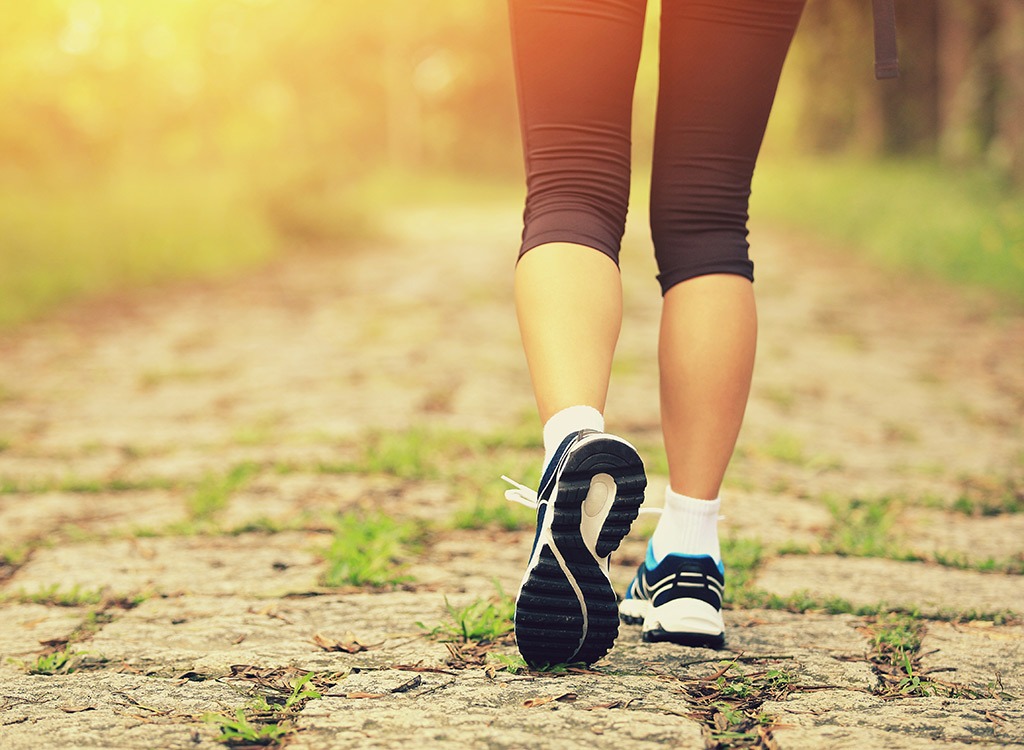One Way to Make Your Daily Walk Way More Effective, Says Science

If you are able, walking is arguably the easiest and most effective way to get regular exercise for good health and fitness. After all, the learning curve is non-existent.
Ah, but is it really? The one way, in fact, the best way, to get the most benefit from your daily walk is to relearn how to walk, suggest numerous studies and a walking expert we spoke with who says the key to making your daily walk more effective is to simply shorten your stride.
“We’re so comfortable with walking that we tend to get lulled into a pace that’s energy-efficient,” says walking coach Michele Stanten, author of Walk Off Weight: Burn 3 Times More Fat with This Proven Program to Trim Your Belly, Butt and Back Fat. Too energy efficient. “We’re not burning enough calories.”
Related: 36 Tips When You’re Walking to Lose Weight, According to Experts
Hundreds of studies have shown that the more you walk the better for all sorts of health reasons: weight loss, lower blood pressure and blood sugar, a better cholesterol profile, stress reduction, improvements in mood, memory, and brainpower, and longevity. (See: What Happens To Your Body When You Walk Every Day.) But the quicker you walk the more efficient and effective your effort will likely be.
“The big mistake most walkers make is taking too long of a stride,” says Stanten. “When your foot lands straight out in front of you it acts almost like a brake and slows you down. By shortening your stride you’ll walk faster and burn more calories.”
How a shorter stride and interval walking can make your walk more effective.
That’s the critical, ahem, step in taking your walk to a new level with a training technique called intervals.
Interval walking is nothing more than walking at a brisk to fast pace for a short period of time, say 30 seconds, followed by 30 seconds to a minute or more of recovery at a slow to moderate pace. Done correctly, interval walking can be challenging, but the potential payoffs are pretty big.
For one, you’ll save time: A 3.5 mph pace will get you home a lot quicker than a leisurely 1.5 mph pace and make it easier to fit a walk into your busy day. Also, just as in other forms of interval training, interval walking—”pushing yourself out of your comfort zone,” says Stanten—increases calorie burn.
The benefits of interval walking.
Danish research presented in Diabetes Care studied people with type 2 diabetes who were randomly assigned to either a continuous-pace walking group that walked at a steady moderate speed or an interval walking group that alternated 3-minute repetitions at low and high intensity. After four months, researchers found that only the interval walkers improved their blood-sugar levels, reduced their BMI (Body Mass Index), and lost dangerous visceral belly fat.
In a related study published in 2015 in the journal Biology Letters, Ohio State University researchers found that walking at varying speeds can burn up to 20% more calories compared to maintaining a steady pace. The researchers put participants on a treadmill set at a steady speed and asked them to walk quickly to the front of the treadmill or slowly moving to the back of the treadmill belt while they monitored their respiration. Their analysis showed that the very act of changing speeds burns more energy because the legs must do more work to move from a slow to a fast pace and vice versa. The researchers estimated that up to eight percent of the energy we use in normal daily walking could be due to the energy needed to speed up and slow down.
Walking at a brisk pace also seems to improve longevity, suggests an analysis in Mayo Clinic Proceedings based on data from almost 475,000 people who were followed for seven years. The study implied that physical fitness is a better indicator of life expectancy than Body Mass Index and engaging in regular brisk walking may add up to 15 years to people’s lives.
Expert tips to make your walk more effective.
Adding two or three days of interval walks to your weekly routine is a simple way to get your heart rate up and build better cardiovascular fitness, says Stanten. Improving your walking form will help you walk faster and get more fitness bang for your buck, she says. We wrangled up some tips to help you make your walk more effective. Read on, and for more, check out The 30-Second Trick for Losing More Weight While Walking.
Keep your chin up.

Don’t hunch over. Stand tall, roll your shoulders back and lift your chest, and keep your chin up. “Look out 10 to 20 feet in front of you instead of down at the ground,” says Stanten. “You’ll still be able to see what’s in front of you and you won’t trip.” Stanten tells the story of a 70-year-old woman with Parkinson’s disease who was training for a walking race. The woman was so nervous about falling that she would only look at her feet while walking. “When I showed her that she could still see the ground by looking ahead, she was so excited because for the first time in years she could enjoy the scenery.”
Bend your arms.

You don’t run with your arms straight so don’t walk with them down either. “Bending and swinging your arms will give you more power; your legs will want to keep up,” says Stanten.
Take shorter steps.

Make your stride shorter by lifting your knees as if marching. Put your lead foot down only about 5 inches in front of your back foot. “Land on your heel, rolling through and pushing off with the ball of your foot and your toes in a smooth stride,” says Stanten.
Speed up, slow down.

Try intervals of 30 seconds at a brisk pace followed by either 30 seconds, a minute, or even more of recovery at a slower walking pace. And keep alternating this way. “Count your steps,” Stanten advises. “Generally, 130 to 137 steps per minute is about 4 miles per hour, so try for about 65 steps in 30 seconds.” If you don’t want to count steps, gauge your intensity by your breathing. At a fast pace, it’ll be very difficult to talk in complete sentences.
Hit the hills.

You can also measure interval periods on a walk using telephone poles or streetlamp posts. Alternate walking at a fast and moderate pace from one to the next. Walking up and down hills is another way to automatically build intervals into your walk because the intensity changes with elevation.
With practice, your brisk walks may even turn into speed walking sessions, where, at a pace of 5 mph, you’ll be burning just as many calories as if you were running. Crank it up to 5.2 mph and you’ll even burn more calories than you would by running because “running is biomechanically easier than walking at that pace,” says Stanten.
Want more walking workouts? Try This 20-Minute Walking Routine to Get Fit and Burn Fat.








